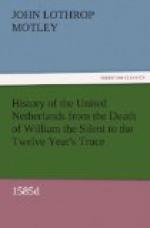After these festivities had been concluded, Parma set himself to practical business. There had been a great opposition, during the discussion of the articles of capitulation to the reconstruction of the famous citadel. That fortress had been always considered, not as a defence of the place against a foreign enemy, but as an instrument to curb the burghers themselves beneath a hostile power. The city magistrates, however, as well as the dean and chief officers in all the guilds and fraternities, were at once changed by Parma—Catholics being uniformly substituted for heretics. In consequence, it was not difficult to bring about a change of opinion in the broad council. It is true that neither Papists nor Calvinists regarded with much satisfaction the prospect of military violence being substituted for civic rule, but in the first effusion of loyalty, and in the triumph of the ancient religion, they forgot the absolute ruin to which their own action was now condemning their city. Champagny, who had once covered himself with glory by his heroic though unsuccessful efforts to save Antwerp from the dreadful “Spanish fury” which had descended from that very citadel, was now appointed governor of the town, and devoted himself to the reconstruction of the hated fortress. “Champagny has particularly aided me,” wrote Parma, “with his rhetoric and clever management, and has brought the broad council itself to propose that the citadel should be rebuilt. It will therefore be done, as by the burghers themselves, without your Majesty or myself appearing to desire it.”
This was, in truth, a triumph of “rhetoric and clever management,” nor could a city well abase itself more completely, kneeling thus cheerfully at its conqueror’s feet, and requesting permission to put the yoke upon its own neck. “The erection of the castle has thus been determined upon,” said Parma, “and I am supposed to know nothing of the resolution.”
A little later he observed that they, were “working away most furiously at the citadel, and that within a month it would be stronger than it ever had been before.”
The building went on, indeed, with astonishing celerity, the fortress rising out of its ruins almost as rapidly, under the hands of the royalists, as it had been demolished, but a few years before, by the patriots. The old foundations still remained, and blocks of houses, which had been constructed out of its ruins, were thrown down that the materials might be again employed in its restoration.
The citizens, impoverished and wretched, humbly demanded that the expense of building the citadel might be in part defrayed by the four hundred thousand florins in which they had been mulcted by the capitulation. “I don’t marvel at this,” said Parma, “for certainly the poor city is most forlorn and poverty-stricken, the heretics having all left it.” It was not long before it was very satisfactorily established, that the presence of those




